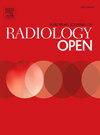人工智能对胸部CT过度扫描的评估:系统回顾和荟萃分析
IF 2.9
Q3 RADIOLOGY, NUCLEAR MEDICINE & MEDICAL IMAGING
引用次数: 0
摘要
扫描范围对CT采集至关重要。然而,CT中不相关的过扫描是常见的,并导致显著的辐射剂量。本文综述了人工智能(AI)在解决胸部CT成像中人工过扫中的作用。方法系统检索Embase、Scopus、Ovid、EBSCOhost和PubMed中2015年12月~ 2025年3月的同行评议论文。两名审稿人和一名学术讲师独立审查了这些文章,以确保符合纳入标准。使用CLAIM和QUADAS-2工具评估纳入研究的质量。通过荟萃分析得出胸部CT扫描范围上下边界过扫描的汇总估计。结果5项研究采用人工智能算法评估低剂量和标准剂量下胸部CT人工过扫描,包括2D地形图或3D轴向图像。这些模型准确地确定了过度扫描的程度,与放射科医生的评估非常一致。所有纳入的研究显示,扫描范围的上(13.5 mm)和下(30.2 mm)边界的过度扫描有显著差异(p <; 0.001),大约三分之二的过度扫描(43.2 mm)发生在下水平(腹部)。结论通过实时监测和回顾性分析,将人工智能工具整合到胸部CT过扫描评估过程中,可通过减少过扫描和辐射剂量,优化胸部CT成像方案,提高患者安全性。本文章由计算机程序翻译,如有差异,请以英文原文为准。
AI-driven assessment of over-scanning in chest CT: A systematic review and meta-analysis
Introduction
Scan range is crucial for CT acquisitions. However, irrelevant over-scanning in CT is common and contributes to a significant radiation dose. This review explores the role of artificial intelligence (AI) in addressing manual over-scanning in chest CT imaging.
Methods
A systematic search of peer-reviewed publications was conducted between December 2015 and March 2025 in Embase, Scopus, Ovid, EBSCOhost, and PubMed. Two reviewers and an academic lecturer independently reviewed the articles to ensure adherence to inclusion criteria. The quality of the included studies was assessed using CLAIM and QUADAS-2 tools. Summary estimates on over-scanning at the upper and lower boundaries of the scan range in chest CT were derived using meta-analysis.
Results
Five studies employed AI algorithms to assess manual over-scanning in chest CT using either 2D topograms or 3D axial images at low and standard doses. These models accurately determine the extent of over-scanning, demonstrating strong agreement with radiologist evaluations. All included studies revealed significant variation in over-scanning at the superior (13.5 mm) and inferior (30.2 mm) boundaries of the scan range (p < 0.001), with approximately two-thirds of the total over-scanning (43.2 mm) occurring at the inferior level (abdomen).
Conclusions
Integrating AI tools into the over-scanning evaluation process may optimise chest CT imaging protocols and enhance patient safety by reducing over-scanning and radiation dose through real-time monitoring and retrospective analysis.
求助全文
通过发布文献求助,成功后即可免费获取论文全文。
去求助
来源期刊

European Journal of Radiology Open
Medicine-Radiology, Nuclear Medicine and Imaging
CiteScore
4.10
自引率
5.00%
发文量
55
审稿时长
51 days
 求助内容:
求助内容: 应助结果提醒方式:
应助结果提醒方式:


